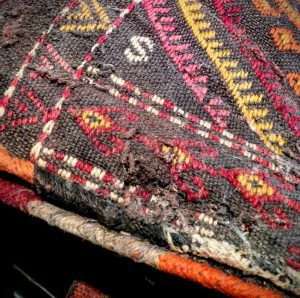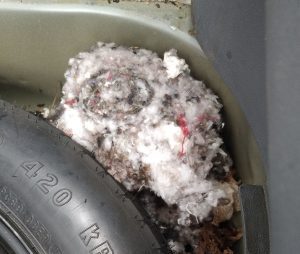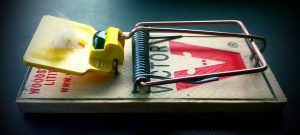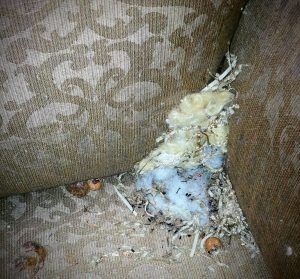NESTING MICE CAN DAMAGE FABRICS
By Chris Williams on September 12, 2018.
What kind of insect would chew big holes out of fabric? My husband tends to throw his dirty clothes in the back of the closet and when I collected them recently there were several good-sized holes, about 2 inches across, in two of his T-shirts. He claims he didn’t tear them on anything and we don’t have any pets that would do that.
L. V., New Castle, NH
There are a few insects that will chew holes into fabrics, but I suspect you might be dealing with a larger pest. Clothes moths and carpet beetles are the main fabric-feeding insects but they chew much smaller holes or simply remove the nap. They are most likely to feed on woolens or wool-blends, not cotton T-shirts, and they prefer soiled areas so I would expect the holes to be around the collar and armpits if these insects were the culprits. They are also often found in close association with the items they’re feeding on so you should have seen the insects or their shed skins, feces, or webbing in the case of clothes moths.

Damage from clothing moths on a rug. Z.Ciras
LOOK BEYOND INSECT FABRIC PESTS
A few larger insects – crickets, cockroaches, and silverfish – will sometimes chew on soiled fabrics, but again damage shouldn’t be that large or obvious. The one pest that can do that kind of damage is a mouse, specifically a female mouse that is constructing her nest. A pregnant female mouse that is nest-building is a force to be reckoned with. She will make as many as 150 foraging trips in a single night to collect individual pieces of nest material and carry them back to her building site.
MOUSE MOM-TO-BE IS SETTING UP HER NURSERY

Mice nesting in spare tire storage area, made nest out of car rug. Z.Ciras
She is looking for anything that is soft, pliable, chewable, and portable, to create the idea nursery for those soon-to-be born baby mice. Typical mouse nest material includes string, insulation, yarn, tissues, furniture stuffing, dryer lint, cotton balls, and of course, shredded strips of soft fabric. This is the really good stuff but when top-of-the-line materials are not available, the female will settle for whatever she can find. In this case, the nest may be made up instead of plastic, leaves, plant stems, and bits of cardboard, or paper. Instead of a pile of softness, the material-deprived nest might be just a few leaves on top of a platform. [Hint: This is why pros bait mouse traps with yarn, cotton balls, even dental floss, in accounts where there is plenty of food but a shortage of nest material!]

Mouse snap trap baited with food and nesting material. Z.Ciras
FINDING THE NEST SITE ISN’T SO EASY

Mice were nesting in a couch stored in a basement. Z.Ciras
When plenty of quality nest material is available, a mouse’s nest may appear as more of a fluffy softball-sized mass, maybe in a dark, back corner of a cabinet, dresser or desk drawer, or even in a closet. Although mice don’t usually travel more than 10 feet or so from their nest to food, the nest could be directly below the closet in the kitchen. Here, preferred nest sites could be under or in the base of appliances, in the stove pan drawer, in little-disturbed bottom cabinets, or beneath bottom cabinet floors behind the kick plate. Or the nest might be totally hidden inside a wall or ceiling void.
Call Colonial Pest and have one of our technician rodent specialists conduct an inspection in your home, looking for further evidence of mice and for that hidden mouse nest, now lined with very soft T-shirt material! Our tech can also look for and seal openings that are letting mice into your house.
For more information on the secret nesting habits of mice, check out these Colonial blogs: